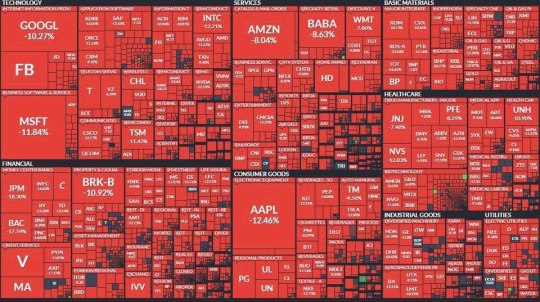#Financial Analysis
Explore tagged Tumblr posts
Text
Create New Income Streams through Online Trading
William Savary’s comprehensive trading course teaches you how to generate consistent income by investing in stocks. Learn the skills you need to diversify your earnings and build a business that thrives in the stock market.
#financial services#financial analysis#autos#beauty#finance#developers & startups#fashion#financial growth#financial investment#musicians
2 notes
·
View notes
Text
Unlocking Financial Insights: Excel Tips by Grayson Garelick
In the realm of financial analysis, Excel stands as an indispensable tool, empowering professionals to dissect complex data, draw meaningful insights, and make informed decisions. Grayson Garelick, a seasoned expert in financial modeling and analysis, shares his insights and expertise on leveraging Excel for financial analysis with confidence. Introduction: Excel in Finance Excel has long been…

View On WordPress
#Excel in Finance#Excel Master#Excel Professional#Financial Analysis#Grayson Garelick#HLOOKUP#VLOOKUP
2 notes
·
View notes
Text
Currency Exchange Trends with Google Finance: Master In-Cell Charts in Google Sheets
✨ Master in-cell currency exchange trend charts in Google Sheets with Google Finance! 📈
Looking for a game-changing way to analyze currency trends over the past 30 days? You're in luck! My latest Reel and blog post show you how to create dynamic in-cell charts using Google Finance. 🚀
Why try this? 🌟 Make data-driven decisions with ease 🌟 Stay on top of currency fluctuations 🌟 Save time with automated insights
🚀 Supercharge your financial analysis with in-cell currency exchange trend charts in Google Sheets! 📊
Looking for a simple yet powerful way to analyze currency exchange trends over the past 30 days? I've got you covered! My latest blog post and video tutorial walk you through the process of creating dynamic in-cell charts using Google Finance.
Why should you try this? 🔹 Enhance your decision-making with data-driven insights 🔹 Keep track of currency fluctuations effortlessly 🔹 Save time with automated data retrieval
Ready to level up your Google Sheets game? Check out the blog post and video tutorial here: https://lnkd.in/enz2Ys2C https://lnkd.in/e5SJPjmj
Don't forget to share your thoughts and experiences in the comments below. Let's learn and grow together! 💡
#GoogleSheets#GoogleFinance#CurrencyExchange#FinancialAnalysis#DataVisualization#data#currency#google#finance
Share your thoughts and experiences below! Let's learn and grow together! 🌱
#GoogleSheets #GoogleFinance #CurrencyExchange #FinancialAnalysis #DataVisualization #Reel
9 notes
·
View notes
Text
Darline Martins has a proven track record of success in the financial world.
6 notes
·
View notes
Text
2 notes
·
View notes
Text
Analyzing #NVIDIA Stock: A Tale of Innovation and Investment
In the dynamic world of technology, few companies have captured the imagination of investors like NVIDIA. As we delve into an in-depth analysis of NVIDIA stock, we uncover a narrative of innovation, resilience, and the potential for substantial returns. Earnings Triumph:NVIDIA’s most recent earnings release is nothing short of remarkable. The company’s consistent ability to exceed quarterly…

View On WordPress
#AI Solutions#Artificial Intelligence#Buy Scenario#Case Study#Earnings Release#Financial Analysis#Future Prospects#Graphics Dominance#Growth Opportunities#Innovation Analysis#Investor Strategy#Market Position#Market Potential#Market Resilience#Market Trends#NVIDIA Stock#Resilience#Stock Analysis#Strategic Investment#Strategic Outlook#Technology Investment#Technology Landscape
2 notes
·
View notes
Text
Don’t celebrate just yet, it’s only been a couple days and despite the shuddering through the market AI won’t be gone for good yet. Nvidia might see a rally sometime soon because with deepseek being able to be run locally there may be an increased demand for Nvidia chips to run the model.
As of now companies like Character.ai use ChatGPT and create avatars that are run over it but this is very expensive for them. In the long run it might be more economical to run it that way. You also have all these tech companies like Google, Meta, and OpenAI that have these chips lying around and will want to experiment with their own models developed in a similiar way to deep seek. They will likely be more powerful since they have a larger budget, more powerful chips, and more chips to train the ai.
I would not jump the gun on the ai bubble popping just yet. If it is popping, then expect to see a significant downturn in the global economy as the last pillar of growth is taken out. If it stays a little longer, a recession that has been looming on the horizon for years could still be avoided


So on the 27th DeepSeek R1 dropped (a chinese version of ChatGPT that is open source, free and beats GPT's 200 dollar subscription, using less resources and less money) and the tech market just had a loss of $1,2 Trillion.
Source

#literally me#deepseek#world news#destiel news#financial analysis#if you disagree I’d love to argue with you
87K notes
·
View notes
Text
youtube
The Postgraduate Financial Accounting and Management Program offered by Imarticus Learning is a comprehensive financial analysis course designed to equip learners with the essential skills and knowledge required to excel in the finance and accounting sector. Targeted at recent graduates and professionals with up to three years of experience, this financial accounting program focuses on the economic, technical, and institutional foundations of accounting and financial management.
A standout feature of this financial analysis course is its 100% job assurance, providing candidates with seven guaranteed interviews to help them secure positions that align with their strengths and career aspirations. The curriculum emphasizes practical, hands-on training, covering essential tools such as MS Office, Power BI, Tally, QuickBooks, and ZOHO, which are vital for growth in a financial and accounting career.
Participants benefit from the expertise of industry professionals with an average of over 15 years of experience, gaining valuable insights into critical financial concepts. The program incorporates realistic finance and accounting simulations, enhancing practical experience and job market readiness. Additionally, learners engage with real-life case studies, developing the ability to analyze data and make informed decisions, which is invaluable in the workplace.
Imarticus Learning, recognized as India's No. 1 in job-assured programs and the first and only approved preparation partner for four global accounting and finance certifications, has a proven track record of empowering careers in finance, data science, analytics, technology, management, and more. Graduates of this financial accounting program have secured positions in leading organizations such as Accenture, Wipro, Genpact, and Goldman Sachs, reflecting the program's effectiveness in facilitating successful career transitions.
0 notes
Text

March 05, 2025
Market Alert
The SOX Index made a great bottom opportunity for a short term trade using the DOJI Candle as a STOPLOSS - Generating Intraday a follow up of approx 200.00 points (4500-4700).
End of Alert
0 notes
Text
Lead Financial Operations: Principal Accountant Opportunity at Gwanda State University! - March 2025
Gwanda State University (GSU) is seeking a skilled and experienced Principal Accountant to join their Bursar’s Department! If you’re a finance professional with a passion for budget management, financial analysis, and ensuring fiscal responsibility, this is an excellent opportunity to contribute to the university’s success. About Gwanda State University: GSU is committed to sound financial…

View On WordPress
#Accounting#Accounting Jobs#budgeting#Budgeting Jobs#business#education#finance#Finance Jobs#Financial Analysis#Gwanda Jobs#JobOpportunity#Management Accounting#University Jobs
1 note
·
View note
Text
John Lasala Shares Top 5 Financial Planning Tips for Beginners in New York

When it comes to financial planning, starting early is the key to long-term success. Whether you're a young professional or someone looking to gain better control over your finances, having a clear plan can set you on the right path. John Lasala, an experienced financial analyst based in New York, shares his top five financial planning tips for beginners. Follow these steps to build a strong financial foundation and secure your future.
1. Set Clear Financial Goals
Financial planning begins with planning what you want to accomplish. The primary objective among your financial targets involves either home ownership or business creation or secure retirement. Your sense of direction and motivation emerges when you establish short-term along with long-term financial targets. John Lasala explains how SMART goals help people maintain their focus through their specificity and measurement ability and achievability and connection to important matters and time-bound nature. The process of financial decision-making simplifies significantly because of well-defined objectives.
2. Create a Realistic Budget
teams play a crucial role in developing financial stability. A budget serves as a foundation for effective financial management because people otherwise risk overspending until they become indebted. According to John you should initially monitor both your financial inflow and outflow. Organize your costs into two sections between essentials like rent utility bills and groceries and non-essential purchases like dining out and paid subscriptions. Applicable budgeting tools along with financial management apps will assist you in proper financial management. A budget system enables people to stay within their income while building funds for upcoming objectives.
3. Build an Emergency Fund
The unexpected nature of life creates financial stress because unexpected expenses force you to lose control of your finances. An emergency fund acts as a safety net which shields you financially from occurring medical expenses and employment interruptions and urgent house maintenance needs. John suggests creating a separate account containing between three and six months of living expenses because of their importance in emergency situations. The financial safety net provides stability since it shields you from borrowing money through credit cards or loans when difficult situations occur.
4. Start Investing Early
John Lasala explains to beginners who refrain from investing because of their risk concerns that the commencement of investment at an early stage allows one to maximize compound interest benefits. Minimal regular contributions will expand substantially through the years. People should begin investing by exploring options such as index funds along with ETFs and employer-sponsored retirement plans including 401(k)s because they carry minimal risk. Arising doubts about your first investment steps can be resolved through advice from financial mentors who will guide you toward wise investment choices.
5. Avoid Unnecessary Debt
Unregulated debt control can cause it to escalate rapidly. All credit card usage and student loan and personal loan handling requires careful financial management. According to John you must pay credit card balances exceeding minimum payments because high-interest debt should be kept at a minimum. You should pay off existing debt through methods such as snowball or avalanche approach even if you already have debt. Being debt-free will provide you with financial freedom as well as stability.
Final Thoughts
People should not feel disheartened by financial planning. The path to a solid financial future becomes achievable when you establish specific goals and handle your budget well and save money for unexpected issues and begin investing before debt control becomes necessary. John Lasala serves as an exceptional expert for New York beginners who wish to gain financial control. Your present actions will produce a bright financial future so begin right now.
0 notes
Text
Course: Effective Financial Modelling in the Power Industry+201010232279
Want to enhance your financial decision-making in the power industry?
Struggling with financial data analysis and risk management?
Join the Effective Financial Modelling in the Power Industry course and gain essential skills!
االجودة الأوربية — European Quality
Build accurate financial models using Excel
Improve project performance with advanced data analysis
Assess risks and make smarter financial decisions
Don’t miss out — secure your spot now!
For inquiries & registration:
+2010 10232279
— — — — — — — — — — — — — — — — — — — —
#financialmodelling#powerindustry#energyfinance#FinanceTraining#RiskManagement#excelforfinance#projectfinance#InvestmentAnalysis#businessgrowth#financialplanning#oilandgas#petroleum #gasandoil#EnergySector#financeprofessionals
financial modelling, power industry, energy finance, financial analysis, risk management, Excel for finance, investment strategies, financial decision-making, project evaluation, corporate finance, energy sector, cost optimization, financial forecasting, capital investment, financial performance

#financialmodelling#powerindustry#energyfinance#FinanceTraining#RiskManagement#excelforfinance#projectfinance#InvestmentAnalysis#businessgrowth#financialplanning#oilandgas#petroleum#gasandoil#EnergySector#financeprofessionals#financial modelling#power industry#energy finance#financial analysis#risk management#Excel for finance#investment strategies#financial decision-making#project evaluation#corporate finance#energy sector#cost optimization#financial forecasting#capital investment#financial performance
0 notes
Link
1 note
·
View note
Text
[Enterprise performance management] EPM software benefits for businesses
EPM software is a powerful tool that enables businesses to plan, budget, forecast, and analyze performance effectively by integrating data from various sources such as ERP, HRMS, WHMS, and customer interactions. It provides comprehensive insights into historical data, helping organizations make informed decisions and optimize resource allocation.
A key advantage of EPM software is its data integration and analysis capabilities, allowing businesses to track key performance indicators (KPIs), generate reports, and visualize data for better strategic alignment. Additionally, planning and forecasting tools help create realistic financial plans, conduct scenario modeling, and optimize operations. By integrating with project management and inventory systems, EPM software ensures seamless alignment between financial goals and operational execution.
Another critical feature is simulation modeling, which allows businesses to conduct "what-if" analyses, test different strategies, and assess risks proactively. By identifying potential challenges and mitigating risks, companies can make data-driven decisions and minimize costly mistakes.
The benefits of EPM software include improved decision-making, automation of planning tasks, enhanced collaboration across departments, and increased operational efficiency. It also helps organizations identify areas for improvement, track progress toward goals, and safeguard financial stability. In an increasingly data-driven world, EPM software is essential for businesses looking to enhance performance and achieve long-term success.
To read the full detailed article click here
#bicxo#business intelligence software#business intelligence#bi tool#businessintelligence#business solutions#bisolution#data#businessefficiency#data warehouse#epmsoftware#epm software#financial consolidation#financial analysis#financial reporting#financialplanning#finance#software services#reporting software#software
0 notes
Text
Keeping the accounts for a small business that primarily sells coffee and cookies….written because I'm going to take a book keeping test in the next week or two.
9:22 am
It is a cool, grey morning in the fall. My friends Jasmine and Drew have stopped by to pick me up. We are going to our usual game of pick up soccer.
But first, a snack.
As usual, I happily pour us a pot of coffee and a dozen cookies while we chat. Then off we go, for a quick jog to the pitch.
And then it’s adulting and errands afterwards.
At least, that’s what I’m thinking when I let them into my studio-sized apartment. And I’m thinking that because that’s what we always do a cool, fall mornings – rain or shine.
Jasmine, however, has other plans that day.
Jasmine: Your cookies are delicious.
Drew: yeah, Finner, I want more!
Also Jasmine: I’ll pay $20 for a dozen cookies and a cup of coffee.
Me, to Jasmine: This is, like, the third time you’ve asked to buy my cookies. You’re serious about this.
I am incredulous – when did this small gesture of friendliness grow to the level of skilled talent? Because this is the third time Jasmine has said something about my cookies and she is not the first, second or third friend to offer money for them.
Jasmine nods emphatically.
I am pleased and a bit apprehensive.
Also Me, to neither one of them in particular: I can haz coffee shop?
Drew, my friend, always the accountant:
Be careful, Finner! Better find out what it will cost to haz you a coffee shop, first.
Also Drew: Don’t worry, I can show you how to figure it out.
And that’s the story of how I started learning book keeping and the accounting equation.
=-=-=-=-=-
It’s been a year so far and here’s what I’ve learned about book keeping for a small business and how it relates to the accounting equation.
Accounts – this is the smallest unit of the equation. There are accounts for each of the activities of the business.
It matters not whether the activity is core to the business or indirectly contributes to the bottom line.
Journal entries – these are what is inside accounts. Basically, if money or cash changes hands, there is a journal entry to record it.
There is also trouble when the entries are not journaled – prepare to go through them with a ruler and great attention to detail.
Balance – generally, accounting principles require that if there is an entry on one side of an account, there must be an equal entry on the opposite side of another account.
Debit and Credit – this is not your banks idea of debits and credits. I’ve also learned that what my girlfiend and mother thinks about debit and credit is not the same thing. Credit card statements too, are not a good frame of reference for this.
On this point, I will defer to another point in time, but just keep in mind that Debits and Credits are everywhere and in every account.
Here’s what is better to understand at the moment:
Every journal entry does something to the value of the business.
This value is referred to as Owner’s Equity or OE for short. No, I don’t mean Old Englishe, the beer, though beer is a wonderful invention.
By OE, I mean the value of the company. As a business owner, this is where your paycheck comes from; and if it is not positive, you don’t get one. So pay attention to it.
While it is important to be aware of what entries – the recording of business activities -are doing the value of the business, OE doesn’t tell the whole story.
Assets and Liabilities also have stories to tell and without them, there is no way of knowing what is going on with OE.
When told, Assets increase the value of OE and Liabilities reduce the value of OE. It is the up down interplay of these two that tells us where OE is at.
And since journal entries happen every day – sometimes hundreds of times in a day – it can be confusing to keep an eye on them all the time.
That’s why quarterly statements are a thing:
Accountants get hired to make the entries and every three months, they pause the making of entries and take a snapshot of what has happened in the business up until then.
Here’s the thing: the snapshots are taken every quarter and then once a year. Think about them like school photos: parents like there kids so the will measure how tall they are every few months and take a photo to remember it by. And then when the kid moves on to the next grade in a year – when the business succesfully stays standing for another year – the school and the parents take another picture.
Except here, the school is the government’s tax agency.
Somewhat irregularly, the auditing firms and regulatory bodies also want these information. That’s why it’s important to use regularly accepted accounting principles – most everybody in the industry uses them same standards so it’s easier to read the books. (these principles are referred to as Generally Accepted Accounting Principles).
Technically, there are three statements that show up four times.
I’ve already hinted at two of them: the Owner’s Equity and the Accounting Equation.
By the way, and this is important, the Accounting Equation is formally written out as
Owner’s Equity = Assets – Liability
and like every addition equation, you can move the pieces around to fit in a way that works for you.
=-=-=-=-==-=-=-=
It is 4 am in the morning here and at this point I got tired of writing. So I will ask my assistant, Chat GPT o3, to help me organize the information about the three statements and how they come together.
It doesn’t do the heavy duty accounting work and is only artificially aware of what’s going on. But I trust it enough that I think it can finish the remainder of the story for you.
Don’t hesitate to let me know if you have questions about any of it – whether it’s the parts I wrote or the parts CGPT-o3 contributed.
And don’t forget that I’m looking forward to hearing the story of your journey, as well, so write me sometime before you arrive.
Best,
Finner
=-=-=-=-=-=-=-==-=-=
11:45 am, January 2057
Hi,
This is C3P - o1.
Finner has asked me to add the following write-up to your letter and mail it out. It lays out the four accounting statements.
My write-up follows in the next page.
Balance Sheet (Statement of Financial Position): This statement presents a snapshot of a company's assets, liabilities, and shareholders' equity at a specific point in time. It follows the fundamental accounting equation: Assets = Liabilities + Equity. The balance sheet provides insights into what the company owns and owes, offering a clear picture of its financial standing. SEC
Income Statement (Profit and Loss Statement): This report details the company's revenues, expenses, and profits or losses over a specific period, such as a quarter or fiscal year. It illustrates how revenues are transformed into net income, highlighting the company's operational performance and profitability. Investopedia
Cash Flow Statement: This statement outlines the cash inflows and outflows from operating, investing, and financing activities during a period. It provides a comprehensive view of how the company generates and utilizes cash, which is crucial for understanding its liquidity and financial flexibility. Corporate Finance Institute
Statement of Shareholders' Equity: This report shows changes in the equity section of the balance sheet over a period. It includes details about retained earnings, issuance or repurchase of stock, and other factors affecting shareholders' equity. This statement helps stakeholders understand the factors contributing to changes in the ownership interest in the company. SEC
Each of these statements offers a different perspective on the company's financial status, and together, they provide a comprehensive overview essential for informed decision-making.
ps - the AI in question is ChatGPT.
#book keeping#accounting#balance sheet#equity#small business#financial accounting#financial reporting#financial analysis
0 notes
Text
Sustainable Finance: The Future of Investment Banking

The financial industry is now experiencing significant changes towards sustainable finance, owing to the growth in awareness concerning ESG factors. This transition is not only a trend but a fundamental transformation in the business of investment banking. For individuals who are or will be in an Investment Banking and Financial Analytics course, there is a high need to be aware of the sustainable finance world since it defines the future.
The Increasing Popularity of ESG Investments
ESG investments have become extremely popular as investors increasingly seek to focus on sustainability and ethics. Investment banks are now beginning to factor ESG criteria into their decision-making processes, which means that the portfolios they invest in will also be sustainable. This is good for the environment and society and also enhances long-term financial performance.
The Role of Technology
Technology is a big driver of the advancement of sustainable finance. Technologies such as blockchain and AI-based analytics are facilitating the assessment of ESG risks and opportunities by investment banks. For example, blockchain technology offers traceability and transparency in supply chains, and AI-driven analytics allow students to track the environmental effects of their investments. Such technological changes are especially relevant to students in an Investment Banking and Financial Analytics course as they are preparing to enter this increasingly changing field.
Regulatory Landscape
Governments and regulatory bodies around the world are increasingly requiring ESG disclosures and sustainable practices. Investment banks must navigate this complex regulatory landscape to remain compliant and competitive. Any course on Investment Banking and Financial Analytics needs to understand these regulations, because they arm future professionals with knowledge on how to manage compliance and leverage regulatory opportunities.
Impact on Investment Strategies
Sustainable finance is changing the investment strategy. Investment banks are now focusing on green bonds, renewable energy projects, and socially responsible investments. These strategies not only contribute to a sustainable future but also attract a growing base of socially conscious investors. For students in an Investment Banking and Financial Analytics course, learning about these innovative investment strategies is essential for staying ahead in the industry.
Challenges and Opportunities
While the new shift towards sustainable finance brings much opportunity, there are also many challenges. First, investment banks need to ensure that profitability goes hand in hand with sustainability while managing ESG risks and complying with fast-changing regulations. Still, these challenges offer opportunities for innovation and growth. By understanding the principles of sustainable finance with an Investment Banking and Financial Analytics course, the future professionals can be the force behind positive change in the industry.
Conclusion
Sustainable finance is no buzzword but the future of investment banking. As the industry continues to evolve, ESG factors, technological advancements, and regulatory compliance will be of the utmost importance. For a candidate pursuing an Investment Banking and Financial Analytics course, understanding sustainable finance is necessary to build a successful and impactful career in investment banking. This change toward sustainability will not only serve the environment but also the wider society, making it a first step towards a more resilient and prosperous financial future.
0 notes